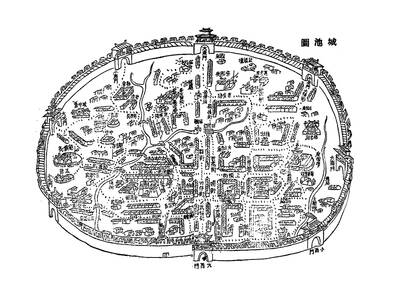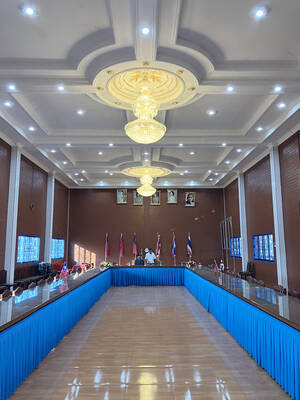This traditional southern Chinese courtyard-style house tucked away in the foothills of Tatun Mountain (大屯山) is worth visiting for many reasons. Operating under a name loosely translated as Inside the Old Wall, the property has been handed down through the Lee (李) family over three generations and serves as an example of how a heritage site can be revitalized with a little love and imagination. Originally built as a family home in 1871, the structure was extensively renovated in 2002, transformed into its current combination of social history museum, restaurant and scenic cafe.
The museum component of Inside the Old Wall is understated, and diners can experience the nostalgia of the restaurant’s setting simply by lounging in the courtyard and watching children play hop-scotch and other simple games on roughly drawn squares. There are plenty of shaded outdoor seats and visitors are protected from the sun not only by large parasols, but also by the big old trees that play as significant a role in shaping Inside the Old Wall’s ambiance as the bricks and mortar.
In the summer months, the heat can make dining outdoors quite an ordeal. Sweltering patrons have the option of eating in the attractive two-story wooden structure behind the main house, as the building contains both an air-conditioned dining area and an upstairs cafe lounge.
The food is best described as home-cooked Taiwanese cuisine — the dishes are tasty enough, if not exactly calculated to wow diners. Inside the Old Wall offers a wide range of stir-fried wild vegetables (NT$100 and up) not readily available at city restaurants. Dishes such as deep fried eel (香酥鰻魚, NT$220), spicy eggplant (魚香茄子, NT$200) and pumpkin with salted duck egg (鹹蛋南瓜, NT$200) are the restaurant’s specialties and are suitable for tables of four and up. While the fare is certainly not fancy, Inside the Old Wall handles salt and oil with an appropriate degree of restraint, which allows the freshness of the ingredients to speak for itself. Service is casual but extremely efficient.
Though the cooking is significantly above par for restaurants found at scenic spots, it is not the cuisine, but Inside the Old Wall’s cafe that is attention grabbing. The cafe area is not air-conditioned and instead relies on its large windows to allow a breeze to waft in. The owners, who also operate a boutique cafe in Jingmei (景美區), Taipei City, take their drinks seriously, roasting their own coffee beans in small batches and providing visitors with a diverse spectrum of interesting teas.
Inside the Old Wall’s thorough approach to beverages is a rarity. The staff takes its time preparing and serving beverages, leaving patrons at their leisure to enjoy the beautiful mountain scenery. Overlooking the magnificent cherry orchards of Tianyuan Temple (天元宮), the view from the restaurant is particularly spectacular during the cherry blossom season in February and March. Bookings are recommended.

May 26 to June 1 When the Qing Dynasty first took control over many parts of Taiwan in 1684, it roughly continued the Kingdom of Tungning’s administrative borders (see below), setting up one prefecture and three counties. The actual area of control covered today’s Chiayi, Tainan and Kaohsiung. The administrative center was in Taiwan Prefecture, in today’s Tainan. But as Han settlement expanded and due to rebellions and other international incidents, the administrative units became more complex. By the time Taiwan became a province of the Qing in 1887, there were three prefectures, eleven counties, three subprefectures and one directly-administered prefecture, with

Taiwan Power Co (Taipower, 台電) and the New Taipei City Government in May last year agreed to allow the activation of a spent fuel storage facility for the Jinshan Nuclear Power Plant in Shihmen District (石門). The deal ended eleven years of legal wrangling. According to the Taipower announcement, the city government engaged in repeated delays, failing to approve water and soil conservation plans. Taipower said at the time that plans for another dry storage facility for the Guosheng Nuclear Power Plant in New Taipei City’s Wanli District (萬里) remained stuck in legal limbo. Later that year an agreement was reached

What does the Taiwan People’s Party (TPP) in the Huang Kuo-chang (黃國昌) era stand for? What sets it apart from their allies, the Chinese Nationalist Party (KMT)? With some shifts in tone and emphasis, the KMT’s stances have not changed significantly since the late 2000s and the era of former president Ma Ying-jeou (馬英九). The Democratic Progressive Party’s (DPP) current platform formed in the mid-2010s under the guidance of Tsai Ing-wen (蔡英文), and current President William Lai (賴清德) campaigned on continuity. Though their ideological stances may be a bit stale, they have the advantage of being broadly understood by the voters.

In a high-rise office building in Taipei’s government district, the primary agency for maintaining links to Thailand’s 108 Yunnan villages — which are home to a population of around 200,000 descendants of the Chinese Nationalist Party (KMT) armies stranded in Thailand following the Chinese Civil War — is the Overseas Community Affairs Council (OCAC). Established in China in 1926, the OCAC was born of a mandate to support Chinese education, culture and economic development in far flung Chinese diaspora communities, which, especially in southeast Asia, had underwritten the military insurgencies against the Qing Dynasty that led to the founding of